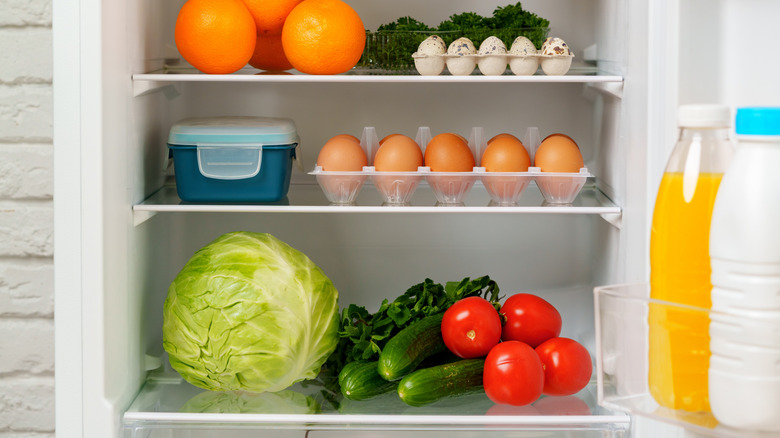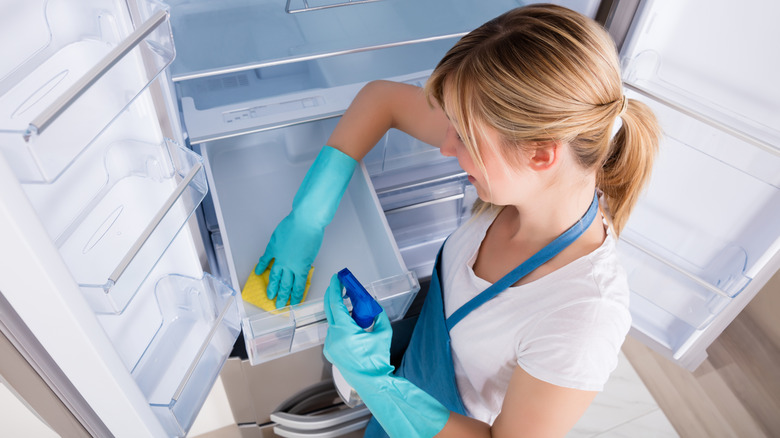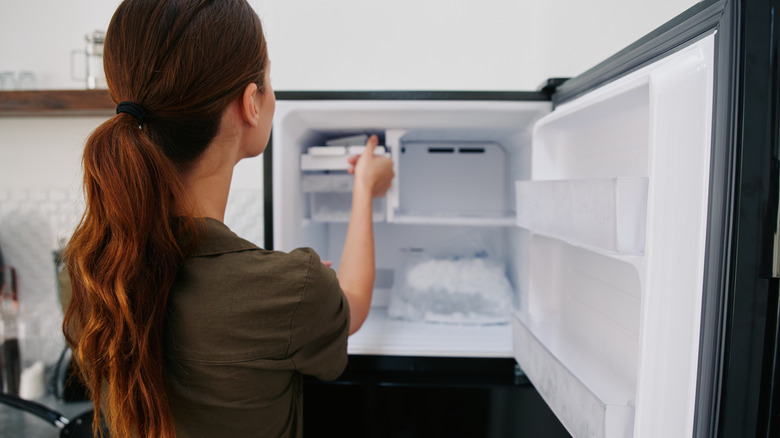How To Keep The Inside Of Your Fridge And Freezer In Tip Top Shape
Refrigerators are an essential kitchen appliance for keeping perishable foods fresh and safe. They also cost a pretty penny, so you naturally want to keep yours in good condition for as long as possible. For insight into fridge and freezer maintenance questions, Mashed spoke with Bree Lemmen, kitchen brand manager for Whirlpool, in an exclusive interview. According to Lemmen, proper care entails a combination of inspection, cleaning, and routine maintenance. In conjunction, these tasks improve efficiency and increase longevity for your refrigerator and freezer.
On the inspection front, Lemmen recommends an annual check of the appliance's door seals to ensure they "are clean and intact to prevent air leaks and improve energy efficiency." Much like the appliance's ice storage compartment, which is an important fridge area that many people forget to clean, door seals are also frequently forgotten when it comes to maintenance. Lemmen also advises, "Check and clean the drain pan periodically to avoid odor and overflow issues." Also known as the drip pan, drain pans serve as a repository for excess condensation generated by the refrigerator. Stagnant water in the pan can contribute to mold and mildew, which can generate bad odors. It's best to clean the drain pan once every three months or so, but check it sooner if you detect any musty smells coming from the fridge.
Best cleaning practices (and why temperature matters)
Cleaning is a crucial part of appliance maintenance, and Bree Lemmen advises that you clean your fridge once every three months for the best results. "Cleaning the refrigerator quarterly will ensure that the food within stays fresh while helping to prevent bacterial growth and fridge odors," she noted. For some help with appliance cleaning, consult our collection of mistakes everyone makes when cleaning the fridge, such as using the wrong tools and products.
Quarterly cleaning sessions are also the perfect time to check the temperature of the refrigerator, according to Lemmen. In the interest of food safety, you should never let your refrigerator go past a certain temperature, which the USDA states is 40 degrees Fahrenheit (although cooler temps are totally fine). As for freezers, the USDA advises the appliance to be set to 0 degrees Fahrenheit to maintain food quality. Maintaining the proper temperature reduces the rate of bacteria growth, so temperatures that breach the safe limit must be investigated immediately to determine whether a repair is necessary.
Other important refrigerator maintenance tasks
Most modern refrigerators have automatic defrosters, but older models may lack this upgraded feature. If this is true of your appliance, Bree Lemmen suggests manually defrosting your freezer on a regular basis to "prevent ice buildup and maintain efficiency." This process is as simple as removing food from the appliance, turning off the power, and opening the doors, but keep in mind that it can take hours or even days for ice to melt. If you want things to move a little faster, boil a pot of water and put it inside the freezer to generate steam to melt the ice quickly. Defrosting the appliance any time ice accumulation equals a quarter inch or half an inch in thickness is recommended for optimal efficiency.
Lemmen also encourages checking that the appliance is level, meaning it's sitting flatly on the floor of your kitchen, at least once per year. Doing so helps "avoid noise, and ensure doors close correctly," which is crucial for maintaining a consistently cold temperature inside the appliance. Remember that Lemmen's guidance can protect your refrigerator and freezer, but it also ensures that the food inside remains safe for consumption and tasting its best.


